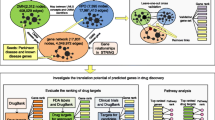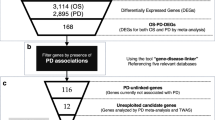Abstract
Parkinson’s disease (PD) is the second-most common neurodegenerative disorder, which is still not established as the exact explanation of the illness. Identifying the target genes associated with the disorder plays a crucial part in managing PD. Different genetic experiments have established the important target genes for disease development, but this remains difficult in the drug designing area. In this research, we suggested a novel approach to disease diagnosis that classifies variant genes for PD using gene mutation, gene expression and analysis of gene deletion. The protein sequence of PD genes was retrieved from genomic databases like NCBI, Ensemble, and UniProtKB and revealed the clinical relevance of various genes mis-sense mutation and amino acid codons. Here the targeted variant genes were identified using sequence matching. Set of PARK genes were identified as target genes by integrating gene mutation and expression data. Gene deletion analysis was carried out to determine the significant target for the Parkinson’s disease. The findings from the suggested mechanism will provide additional insight for understanding the disease mechanism of PD. This changes help drug designer for specific treatment. Future enhancement of this study may help in predicting disease biomarkers as well as designing novel compounds in rational drug designing.









Similar content being viewed by others
Explore related subjects
Discover the latest articles, news and stories from top researchers in related subjects.References
Alafeef M, Fraiwan M (2019) On the diagnosis of idiopathic Parkinson’s disease using continuous wavelet transform complex plot. J Ambient Intell Human Comput 10(7):2805–2815
Anusha B, Geetha P (2018) Biomedical voice based parkinson disorder identification for homosapiens. In: Computational vision and bio inspired computing, vol 28. Springer, Cham, pp 641–651. https://doi.org/10.1007/978-3-319-71767-8_56
Brabenec L et al (2017) Speech disorders in Parkinson’s disease: early diagnostics and effects of medication and brain stimulation. J Neural Transm 124(3):303–334
Brewer BR, Pradhan S, Carvell G, Delitto A (2014) Application of modified regression techniques to a quantitative assessment for the motor signs of Parkinson’s disease. IEEE Trans Neural Syst Rehab Eng. 17(6):568–575. https://doi.org/10.1109/TNSRE.2009.2034461
Brüggemann N, Klein C (2013) Parkin type of early-onset Parkinson disease. In: GeneReviews® [Internet]. University of Washington, Seattle
Burch M, Kurzhals K, Kleinhans N, Weiskopf D (2018) EyeMSA: exploring eye movement data with pairwise and multiple sequence alignment. In ETRA 52–1
Chai C, Lim KL (2013) Genetic insights into sporadic Parkinson’s disease pathogenesis. Curr Genom 14(8):486–501
Chen B-R et al (2010) A web-based system for home monitoring of patients with Parkinson’s disease using wearable sensors. IEEE Trans Biomed Eng 58(3):831–836
Chen L, Hagenah J, Mertins A (2012) Feature analysis for Parkinson’s disease detection based on transcranial sonography image. In: International conference on medical image computing and computer-assisted intervention, vol 7512. Springer, Berlin, Heidelberg, pp 272–279. https://doi.org/10.1007/978-3-642-33454-2_34
Chowdhury B, Garai G (2017) A review on multiple sequence alignment from the perspective of genetic algorithm. Genomics 109(5–6):419–431
Demonceau M et al (2015) Contribution of a trunk accelerometer system to the characterization of gait in patients with mild-to-moderate Parkinson’s disease. IEEE J Biomed Health Inform 19(6):1803–1808
Dimauro G et al (2017) Assessment of speech intelligibility in Parkinson’s disease using a speech-to-text system. IEEE Access 5:22199–22208
Djurić-Jovičić MD, Jovičić NS, Radovanović SM, Stanković ID, Popović MB, Kostić VS (2014) Automatic identification and classification of freezing of gait episodes in Parkinson’s disease patients. IEEE Trans Neural Syst Rehabil Eng 22(3):685–694
Giuberti M, Ferrari G, Contin L, Cimolin V, Azzaro C, Albani G, Mauro A (2015) Assigning UPDRS scores in the leg agility task of Parkinsonians: can it be done through BSN-based kinematic variables? IEEE Internet Things J 2(1):41–51
Giuberti M, Ferrari G, Contin L, Cimolin V, Azzaro C, Albani G, Mauro A (2015) Automatic UPDRS evaluation in the sit-to-stand task of Parkinsonians: kinematic analysis and comparative outlook on the leg agility task. IEEE J Biomed Health Informat 19(3):803–814
Gümüşçü A et al (2017) Genetic algorithm based feature selection on diagnosis of Parkinson disease via vocal analysis2017 25th signal processing and communications applications conference (SIU). IEEE
Hicks S, Wheeler DA, Plon SE, Kimmel M (2011) Prediction of missense mutation functionality depends on both the algorithm and sequence alignment employed. Hum Mutat 32(6):661–668
Hirschauer TJ, Adeli H, Buford JA (2015) Computer-aided diagnosis of Parkinson’s disease using enhanced probabilistic neural network. J Med Syst 39(11):179
Jane YN, Nehemiah HK, Arputharaj K (2016) A Q-backpropagated time delay neural network for diagnosing severity of gait disturbances in Parkinson’s disease. J Biomed Inform 60:169–176
Kim M, Won JH, Youn J, Park H (2019) Joint-connectivity-based sparse canonical correlation analysis of imaging genetics for detecting biomarkers of Parkinson’s disease. IEEE Trans Med Imag 39(1):23–34. https://doi.org/10.1109/TMI.2019.2918839
Klein C (2006) Implications of genetics on the diagnosis and care of patients with Parkinson disease. Arch Neurol 63(3):328–334
Klein C, Westenberger A (2012) Genetics of Parkinson’s disease. Cold Spring Harb Perspect Med 2(1):a008888
Li KF (2013) Smart home technology for telemedicine and emergency management. J Ambient Intell Human Comput 4(5):535–546
Little MA, McSharry PE, Hunter EJ et al (2009) Suitability of dysphonia measurements for telemonitoring of Parkinson’s disease. IEEE Trans Biomed Eng 56(4):1015–1022
Maiti P, Manna J, Dunbar GL (2017) Current understanding of the molecular mechanisms in Parkinson’s disease: targets for potential treatments. Transl Neurodegener 6(1):28
Mašić F et al (2017) Detection of Parkinson’s disease by voice signal. International symposium on innovative and interdisciplinary applications of advanced technologies. Springer, Cham
Muhamad FN, Ahmad RB, Asi SM, Murad MN (2018) Performance Analysis of Needleman-Wunsch algorithm (global) and Smith-Waterman algorithm (local) in reducing search space and time for DNA sequence alignment. J Phys Conf Ser 1019:012085
Notredame C (2007) Recent evolutions of multiple sequence alignment algorithms. PLoS Comput Biol 3(8):e123
Page D, Jahanshahi M (2007) Deep brain stimulation of the subthalamic nucleus improves set shifting but does not affect dual task performance in Parkinson’s disease. IEEE Trans Neural Syst Rehab Eng 15(2):198–206
Pahuja G, Nagabhushan TN (2016) A novel GA-ELM approach for Parkinson’s disease detection using brain structural T1-weighted MRI data. 2016 Second international conference on cognitive computing and information processing (CCIP). IEEE
Parisi F, Ferrari G, Giuberti M, Contin L, Cimolin V, Azzaro C, Albani G Mauro A (2014) Low-complexity inertial sensor-based characterization of th UPDRS score in the gait task of Parkinsonians, presented at the 9th Int Conf Body Area Netw, London, U.K., Sep/Oct
Parisi F et al (2015) Body-sensor-network-based kinematic characterization and comparative outlook of UPDRS scoring in leg agility, sit-to-stand, and Gait tasks in Parkinson’s disease. IEEE J Biomed Health Inform 19(6):1777–1793
Parisi F, Ferrari G, Giuberti M, Contin L, Cimolin V, Azzaro C, Albani G, Mauro A (2015) Inertial BSN-based characterization and automatic UPDRS evaluation of the gait task of Parkinsonians. IEEE Trans Affective Comput [Online] http://www.tlc.unipr.it/ferrari/TAFFC_Parisi_et_al_Feb2015.pdf. Accessed 15 Aug 2018
Pasluosta CF et al (2015) An emerging era in the management of Parkinson’s disease: wearable technologies and the internet of things. IEEE J Biomed Health Inform 19(6):1873–1881
Rahmim A, Huang P, Shenkov N, Fotouhi S, Davoodi-Bojd E, Lu L, Mari Z, Soltanian-Zadeh H, Sossi V (2017) Improved prediction of outcome in Parkinson's disease using radionics analysis of longitudinal DAT SPECT images. NeuroImage Clinical 16:539–544
Rechy-Ramirez EJ et al (2018) Impact of commercial sensors in human computer interaction: a review. J Ambient Intell Human Comput 9(5):1479–1496
Sakar BE, Isenkul ME, Sakar CO, Sertbas A, Gurgen F, Delil S, Apaydin H, Kursun O (2013) Collection and analysis of a Parkinson speech dataset with multiple types of sound recordings. IEEE J Biomed Health Inform 17(4):828–834
Salarian A et al (2004) Gait assessment in Parkinson’s disease: toward an ambulatory system for long-term monitoring. IEEE Trans Biomed Eng 51(8):1434–1443
Schulte C, Gasser T (2011) Genetic basis of Parkinson’s disease: inheritance, penetrance, and expression. Appl Clin Genet 4:67
Shirvan, Arefi R, Tahami E (2011) Voice analysis for detecting Parkinson’s disease using genetic algorithm and KNN classification method. 2011 18th Iranian conference of biomedical engineering (ICBME). IEEE
Sivaranjini S, Sujatha CM (2019) Deep learning based diagnosis of Parkinson’s disease using convolutional neural network. Multimed Tools Appl 79:15467–15479. https://doi.org/10.1007/s11042-019-7469-8
Tsanas A et al (2009) Accurate telemonitoring of Parkinson’s disease progression by noninvasive speech tests. IEEE Trans Biomed Eng 57(4):884–893
Tsanas A, Little M, McSharry PE et al (2010) New nonlinear markers and insights into speech signal degradation for effective tracking of Parkinson’s disease symptom severity, international symposium on nonlinear theory and its applications (NOLTA), Krakow, Poland, pp 457–460, 5–8, Sep 2010
Valli A, Jiji GW (2014) Parkinsons disease diagnosis using image processing techniques a survey. Int J Comput Sci Appl 4(6):55–67
Xiao H (2012) Diagnosis of Parkinson’s disease using genetic algorithm and support vector machine with acoustic characteristics. 2012 5th International conference on biomedical engineering and informatics. IEEE
Zeng W, Liu F, Wang Q, Wang Y, Ma L, Zhang Y (2016) Parkinson’s disease classification using gait analysis via deterministic learning. Neurosci Lett 633:268–278
Author information
Authors and Affiliations
Corresponding author
Rights and permissions
About this article
Cite this article
Anusha, B., Geetha, P. Identification of gene variant associated with Parkinson’s disease using genomic databases. J Ambient Intell Human Comput 13, 5211–5224 (2022). https://doi.org/10.1007/s12652-021-02994-4
Received:
Accepted:
Published:
Issue Date:
DOI: https://doi.org/10.1007/s12652-021-02994-4




